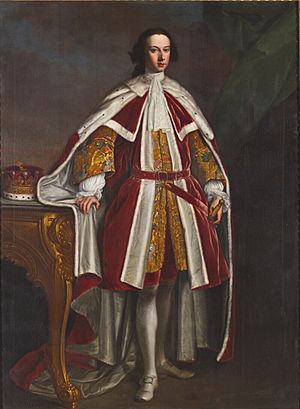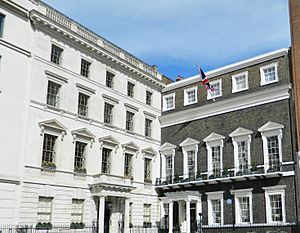William Wentworth, 2nd Earl of Strafford (1722–1791) facts for kids
William Wentworth, 2nd Earl of Strafford (born March 17, 1722 – died March 10, 1791) was an important person in British history. He held a special title called "Earl of Strafford." Before 1739, people called him Viscount Wentworth. As an Earl, he was a member of the House of Lords, which is part of the British Parliament.
Family Background and Life
William Wentworth was the only son of Thomas Wentworth, 1st Earl of Strafford (1672-1739). His family had a long history with important titles. His father received the title of Earl of Strafford in 1711. When his father passed away in 1739, William inherited this title. This meant he became the 2nd Earl of Strafford.
William's mother was Anne Johnson. She came from a wealthy family. Even though her family was rich, people said her parents had a very happy marriage.
Unlike his father, William Wentworth was not as involved in politics. However, he did have some official roles. For example, he was appointed a deputy lieutenant for the West Riding of Yorkshire in 1757. This role involved helping with local government and military matters.
Designing and Building Homes

William Wentworth was very interested in architecture and building. He made big changes to Wentworth Castle, his large country home in Yorkshire. He added a new section to the castle between 1759 and 1764. This new part was built in a style called neo-Palladian. This style was popular at the time and was inspired by ancient Roman and Greek buildings.
His friend, Horace Walpole, who was also a writer, greatly admired Wentworth Castle. In 1770, Walpole wrote that the new part of the castle showed "the most perfect taste in architecture." He praised how beautiful and grand it looked, blending well with the surrounding nature.
William Wentworth also built a grand house in London. This house, called Wentworth House, was located at 5, St James's Square. He built it between 1748 and 1751. It was designed by an architect named Matthew Brettingham The Elder. This house remained in his family for many years.
Marriage and Family Life
In 1741, William Wentworth married Lady Anne Campbell. She was one of five daughters of John Campbell, 2nd Duke of Argyll. Lady Anne was known for her beauty. A famous writer, Horace Walpole, even wrote a poem about her in 1765.
William and Anne were part of a social group that included many important people, like Horace Walpole. They did not have any children.
Lady Anne passed away in 1785. William Wentworth died in 1791. Since he had no children, his title was passed on to his cousin's son, Frederick Wentworth, 3rd Earl of Strafford.
Portraits
Several artists painted portraits of William Wentworth and his wife. One famous portrait of William was done by Sir Joshua Reynolds. Sir Joshua Reynolds also painted a beautiful portrait of Lady Anne, which is now in the Minneapolis Institute of Arts.
|



